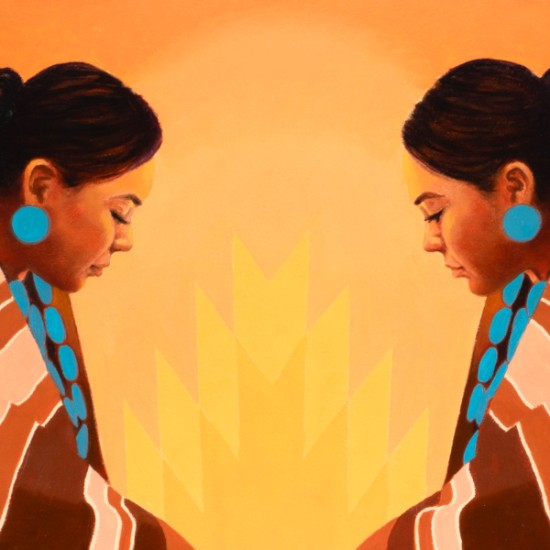When Karen Clarkson selects subjects for her original paintings of Native women, she’s less concerned with their physical beauty than their implicit backstory, which she reveals through facial expressions, bodily postures, and manner of dress. Her ability to observe the world through the eyes of these people offers us fresh perspectives and a new understanding of their place in the world.
“I find each painting is truly a journey of revelation that allows me to communicate feelings that are ever present, and which propel me forward,” Clarkson says. “I want my audience to see this in all its beautiful complexity, whether it be hope, love, or determination.”
This she accomplishes so well that when we look at her portraits in oils, we find far more than just static representations of attractive people. Her subjects—Native women who must straddle Native and Anglo cultures both ancient and modern—are presented as recognizable, knowable, fully realized individuals whose expressions encompass the full range of human emotion but simultaneously retain an aura of mystery despite their accessibility.
“I began my artistic journey by creating portraits of people I admired,” Clarkson says. “I taught myself to draw by using old photos of my family and their ancestors as references. This led to many discoveries about my Choctaw heritage. In choosing my subjects I first consider what they should convey; I’m not interested in painting beautiful women just to show how attractive they can be. I am drawn by women who show their beauty through determination, culture, and sense of purpose.”
Some of Clarkson’s portraits are interactive works in which she embeds QR codes that link viewers to sources of information about the issues represented in the paintings. She considers this an important educational tool as she takes us beyond the stereotypes to show us the sacred aspects of quotidian behaviors. While not overtly political, Clarkson subtly and symbolically addresses the many pressing issues these women face, all the while showcasing the complexity that makes them relatable as she gently but deliberately pierces stereotypes and shatters misconceptions.
Clarkson’s work adds yet another dimension to our understanding of Native culture, revealing the inner character of her subjects as well as showcasing their beauty. Her growing list of awards—among them the Arizona Governor’s Choice Award in 2024; the Grand Award, Indigenous Collection, Santa Fe Indian Market, Sept 2021; Best of Show, Choctaw Nation Indian Arts Show, in 2013, 2015, and 2016, and many others—attests to the appeal of Clarkson’s work. She was especially honored when she was selected to supply the cover image for Native American Art magazine’s commemoration of the 100th anniversary of Indian Market.
“My desire to communicate what is important to me remains the most important component of my art,” Clarkson says. “To sense the humanity in another person and to be able to convey it through art opens a whole other world and a new mode of communication. It is bringing the intangible into focus and making room for change.”
Visit Blue Rain Gallery in Santa Fe, NM to view Clarkson's thought provoking portraits today!

















